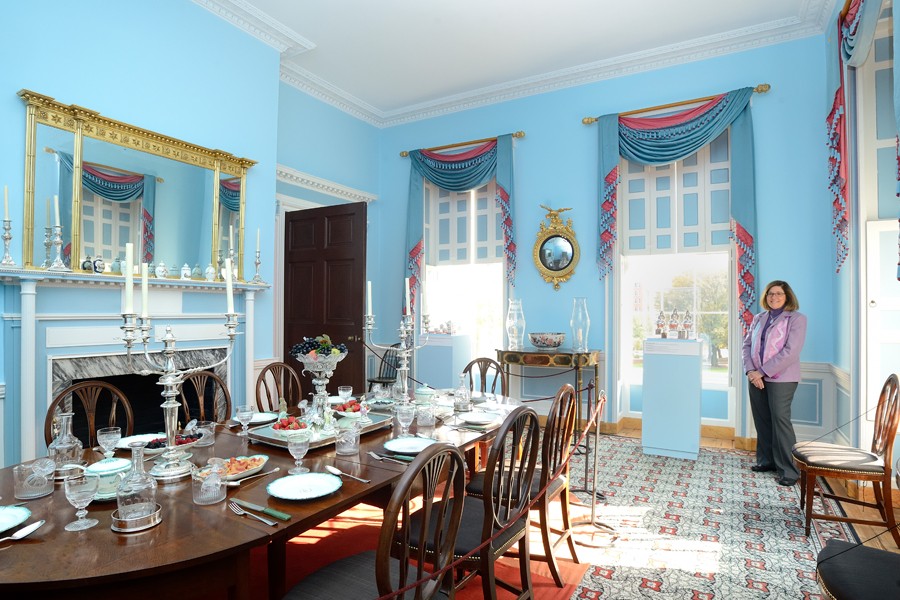When Julia "Julie" Rose arrived in June as the new director and curator of Homewood Museum, she was excited to preside over the painstakingly curated collection, housed in the historically significant home of a prominent Maryland family.
Built in 1801, as a gift from Declaration of Independence signer Charles Carroll to his son, Charles Carroll Jr., the home is now a National Historic Landmark, boasting Federal architecture plus an array of historically accurate artifacts, a smattering of which were owned by the Carroll family.
As thrilled as she was with the collection, Rose also was eager to steer the museum in new and interesting ways, changing the narrative that has always focused squarely on the lives of Charles Carroll Jr. and his family.
"I'm very committed to elevating and expanding the historical representation of enslaved communities," says Rose, who plans to unveil a reworked tour in 2018 that explores the lives of all who lived in the home.
The new Families of Homewood tour comes thanks to a grant that funded a historian's research into the enslaved community at the property, details that will allow the museum to present a fuller picture of an integrated household. "There were free, enslaved, black, white, mixed race individuals; children, adults, and multiple generations of families, all in this space over the course of roughly 25 years," Rose says.

Image caption: Rose in the butler’s pantry, where part of the current exhibition As Precious as Gold: History of Tea Caddies from the Bramble Collection is on display (through Dec. 30).
Image credit: Will Kirk / Johns Hopkins University
The tour won't roll out until spring or summer, but whether you visit then or now you'll get a fascinating look at the furniture, rugs, silver, porcelain, art, and other items that tell the story of life in early 19th-century Baltimore. And while the home is chocablock with items of interest, Rose points out a few significant pieces and places you should be sure not to miss.
The dining room, close up
If you've visited in the past and had to peer into the dining room from the roped-off doorway, you'll be pleased to hear that visitors can now enter the room and see it up close and in full. That's in part due to the installation of a new, smaller dining room table, in the historically appropriate Federal style. In addition to the elaborate table settings—which change throughout the year—be sure to check out the JHU student exhibit at the south end of the table that shows a sample of items excavated on site as part of the archaeology program.
A rare chair
A painted black chair—one of a handful of items owned by the Carrolls and used in their home—is on display in the back parlor, where the family would have gathered to relax or play games. The black-and-gilt-painted armchair, on loan from the Maryland Historical Society, is the only known surviving piece of furniture originally used in the house.
A butler's life
To get a glimpse of a slave's life, pay attention in the butler's pantry to the bedding wrap stored on the floor in the southwest corner of the room. Instead of sleeping in his own room with his wife, Carroll's enslaved butler, William Ross, would have used similar bedding, parked outside Carroll's bedroom door so that he could quickly provide whatever Carroll needed.
Guest exhibitions
In addition to its permanent collection, the museum hosts exhibitions throughout the year. The latest, As Precious as Gold: History of Tea Caddies from the Bramble Collection, is curated by theater director, author, and producer Mark Bramble, along with Baltimore-based Stiles Colwill, and features accoutrements of 18th- and 19th-century tea service, on display throughout the house through Dec. 30. With more than 150 tea caddies and silver tea service sets, "the exhibit is an incredible opportunity for Homewood Museum to explore the ties among objects of beauty, craftsmanship, and world history," Rose says.
A local tie
The collection features several pieces of furniture crafted and hand-painted in Baltimore in the early 1800s in a style comparable to what might have been found in the home. In the reception hall, you'll find a settee and chair set, constructed by Thomas Renshaw and hand-painted by Renshaw's ornamenter in a shade of mustard yellow that was wildly popular at the time. In the master bedroom, a handsome green cradle—"one of the museum's premier pieces," Rose says—is another example of outstanding painted Baltimore furniture.
A best-guest's writing desk
In the bedroom the museum has dubbed "the best-guest chamber," you'll find one of the prized possessions linked to the family: a portable writing desk that belonged to Charles Carroll of Carrollton, who likely brought it to the home on the many occasions he visited his son and daughter-in-law. "This is like an early laptop," Rose says with a laugh. Complete with feather quill and ink, the desk has the Carroll family crest on its lid.
A quirky clock
Gracing the mantel in a front parlor is a George Washington commemorative clock, part of the collection since the museum's inception. The clock, complete with its original glass dome, reflects the family's link to Washington and the nation's founding. And while the clock style is one found in other museums, this particular example has a minor quirk: The inscription rephrases part of the eulogy written by Henry "Light Horse Harry" Lee (we won't keep you in suspense: It says "First in War, First in Peace, First in his Countrymen's Hearts" instead of "First in War, First in Peace, and First in the Hearts of His Countrymen").
Visiting
Where: Johns Hopkins University Homewood campus, 3400 N. Charles St., Baltimore, MD 21218. Hours: By guided tour only. Tues. to Fri., 11 a.m. to 4 p.m.; Sat. and Sun., noon to 4 p.m. Tours begin every half hour, with the last starting at 3:30 p.m. Closed Mondays, New Year's Day, Easter Sunday, Independence Day, Thanksgiving Day, Christmas Eve, and Christmas Day.
More information: museums.jhu.edu or 410.516.5589.
Cost: $8 adults; $7 seniors (65+); $5 students with ID, youth (6-17), and JHU alumni and retirees; FREE for JHU faculty, staff, and students with ID; museum members; and children 5 and under.
Upcoming events: Dec. 2: Museum decorated for the holidays; Dec. 2-10: discount shopping days in the Homewood and Evergreen museum shops (10 percent off for those with a valid Johns Hopkins ID); Dec. 4: Homewood by Candlelight; through Dec. 30: Tea caddy exhibition; Jan. 13: Caring for Your Family Photographs: Digital Images and Images on Paper workshop ($15/$12 members).
Posted in News+Info, Benefits+Perks, Happenings
Tagged music + museums + more









